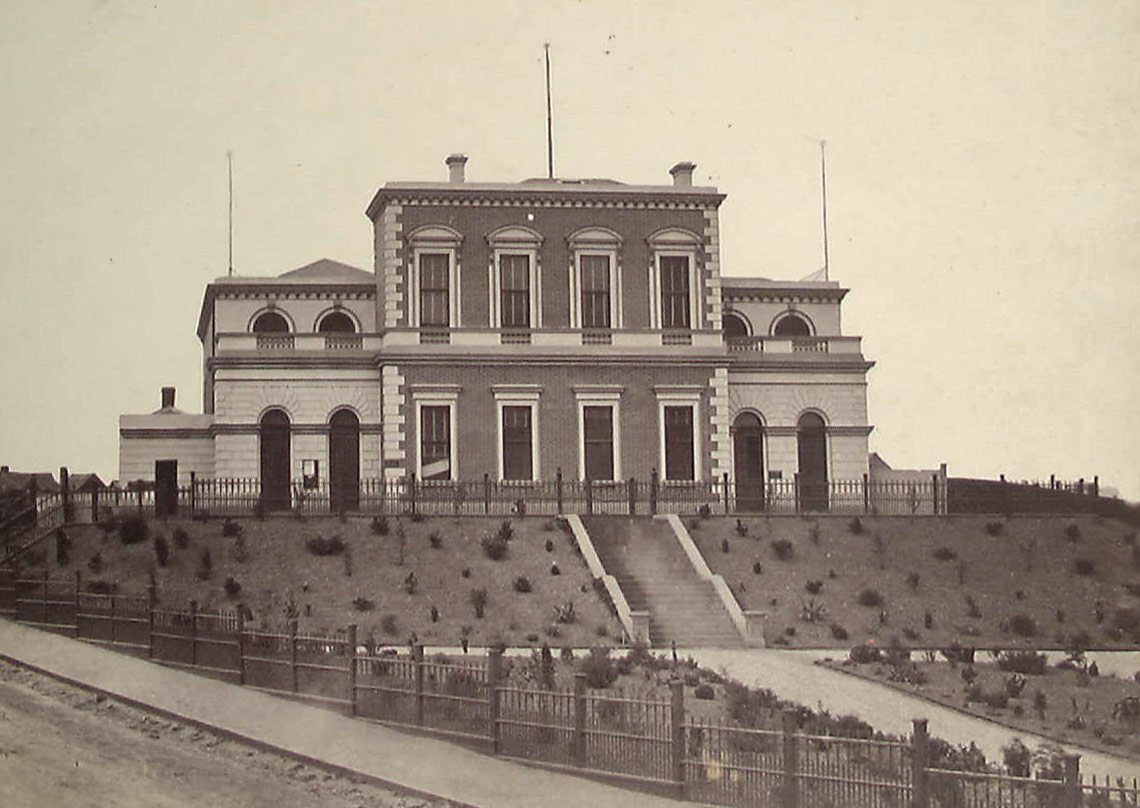
Ballarat East Town Hall, c.1860s.
IMAGE COURTESY OF STATE LIBRARY VICTORIA, H1773.
This is the room in which all the major decisions relating to the management of the City of Ballarat have been made for more than 150 years. If these walls could talk, they would tell us stories of fierce debate, conflict and compromise. They would tell us of the passion and dedication of the people who have served the citizens of Ballarat over the years.
The City of Ballarat as it exists today was formed in 1994 through an amalgamation of the former City of Ballaarat, the Shire of Ballarat, the Borough of Sebastopol and parts of the Shires of Bungaree, Buninyong, Grenville and Ripon.1 This amalgamation was part of the Kennett government’s sweeping changes to local councils in Victoria, which saw the number of municipalities reduced from 210 to 78.2 One local paper reported that 200 people attended the final meeting of the former City of Ballaarat Council in May 1994.3 It was a trying time and reactions to Ballarat’s new ‘super council’ were mixed. While it was a significant period of change for the City of Ballarat, it was not the first time the council had addressed the question of amalgamation.
Almost from the time they were created, the municipalities of west Ballarat (known as Ballarat) and Ballarat East were in competition.
Despite their close proximity and the obvious advantages of amalgamation, the residents in each municipality were strongly opposed to it. Residents in the east felt it would mean the loss of government subsidies, independence and identity, while residents in the west were concerned about the expense of building roads that were needed in the east, and felt threatened by its community, which was a more cosmopolitan mix of gold seekers, immigrants and the working classes.4 At the time, there were still strong emotional reasons for resisting amalgamation, stemming from the recent events at Eureka when the two communities had essentially faced off on opposite sides of the conflict.5
As Ballarat grew, there were further discussions about amalgamation, but all of them failed. In 1910, the ratepayers of Ballarat East voted on the question of amalgamation, with 907 voting in favour of joining with the west, or as it was then known, the City of Ballarat. But more than 1,941 voted against the motion.6 Ten years later, after almost seven decades of separation, both municipalities voted in favour of amalgamation, forming a united City of Ballaarat. Despite inclement weather, people came together from all across the city to celebrate this historic occasion.7
REFERENCES
[1] ‘Municipal History’, City of Ballarat, www.ballarat.vic.gov.au/ac/municipal-history.aspx, accessed 12 June 2018.
[2] ‘Kennett’s blitz a decade on’, The Age, 25 April 2004, www.theage.com.au/articles/2004/04/24/1082719671977.html, accessed 12 June 2018.
[3] ‘From Ballaarat to Ballarat: What’s really in a name?’, The Land, 7 April 2017, www.theland.com.au/story/4839355/from-ballaarat-to-ballarat-whats-really-in-a-name/, accessed 12 June 2018.
[4] Weston Bate, Lucky City: the first generation at Ballarat 1851-1901, Carlton, Victoria, Melbourne University Press, 2003, p. 183.
[5] Bate, 2003, p. 183.
[6] The Geelong Advertiser, 26 August 1910, p. 4.
[7] Table Talk, 2 June 1921, p. 22.